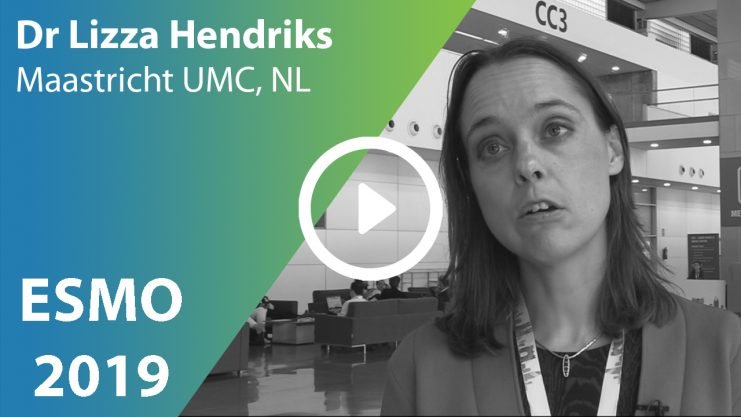Advertisment
Oligorecurrent and oligoprogressive NSCLC

Oligorecurrent and oligoprogressive NSCLC represent a treatment challenge. A case example of synchronous oligometastatic disease provided the framework for expert discussion……..
Written by Christine Clark.
Case example
A 65-year-old woman, former smoker (50 pack years) presented in January 2014 with a left-sided, painless, supraclavicular lymph node. She had no pulmonary symptoms, no weight loss and a performance score of 0. Investigations showed a primary left lower lobe (LLL) non-small cell lung cancer (NSCLC), bulky mediastinal lymph nodes and an involved axillary lymph node. The tumour had wild-type genes. She received three courses of concurrent chemo-radiation but developed grade 3 radiation oesophagitis. By July 2015 she had developed a new LLL lesion and a brain lesion – i.e. oligo-progressive disease. She then underwent stereotactic radiotherapy (SRT) to the brain and a lobectomy for the lung disease. Neoadjuvant chemotherapy was planned but was refused by the patient. By January 2017 the brain lesion had progressed with leptomeningeal involvement and the treatment choice lay between whole brain radiotherapy (WBRT) or follow-up. The patient chose follow-up. By April 2017 there was further progression and WBRT was administered. By October 2017 there was extra-cranial disease progression. Dexamethasone was prescribed. As a previous tumour tissue sample showed PD-L1 tumour proportion score (TPS) of 95%, pembrolizumab was prescribed. After two cycles of pembrolizumab she deteriorated rapidly developing a painful bone metastasis and progressive lymph node disease. Palliative RT and best supportive care were given.
Radiology perspective
A meta-analysis of individual patients with oligo-metastatic lung cancer showed that surgery was the most common treatment for both primary tumours and metastatic disease, Professor Suresh Senan (Amsterdam University Medical Centre, The Netherlands) told the audience. The median overall survival (OS) was 26 months with a five-year OS of 29.4%, he continued. Further analysis showed that patients with low-risk metachronous metastases fared best (five-year OS 48%) but those with high-risk, synchronous N1/N2 disease had a five-year OS of 14%. This patient had synchronous metastases and oligorecurrence, he noted.
The ESMO clinical practice guideline says that Stage IV patients with up to three synchronous metastases at diagnosis may experience long-term disease-free survival following systemic therapy and local consolidative therapy (high-dose RT or surgery) but should be discussed in a multidisciplinary tumour board and included in clinical trials if possible.
However, two recent randomised trials in patients with synchronous metastases closed prematurely. “Without local ablative therapy (LAT) survival in stage IV after systemic therapy is short”, said Professor Senan.
The expert consensus on synchronous oligo-metastatic disease (OMD) holds that the definition is relevant when radical treatment is technically feasible for all tumour sites with acceptable toxicity. OMD is defined as a maximum of five metastases in three organs. Mediastinal lymph node involvement is considered to be loco-regional disease.
In this case – a 65 year old woman with a good performance status – Professor Senan would have preferred to give induction chemotherapy (CT), then RT. A large radiation field increases risk of Grade 3 – 4 oesophagitis and pneumonitis. Grade 3 oesophagitis is a serious and unpleasant complication that calls for tube feeding, total parenteral nutrition or hospitalisation, he noted.
Considering re-irradiation with stereotactic ablative radiation (SABR) this could be more toxic than the first irradiation – more chest wall pain and the possibility of fractures. “SABR is not without risk – in the SABR-COMET trial some patients died!”, said Professor Senan.
This patient later received pembrolizumab for extracranial disease progression: The PEMBRO-RT trial compared pembrolizumab after SBRT with pembrolizumab alone in patients with advanced NSCLC. Although the response rate at 12 months doubled, this did not meet the pre-specified end-point and so the results were scored as negative, he said.
This patient died four years after first presenting. Such cases call for the best possible local treatment. Although completed trials that show increased progression-free survival (PFS) excite much interest, what really matters is increased overall survival, said Professor Senan.
Surgical perspective
In OMD the current recommendation concerning invasive staging of the mediastinum is not strict enough, according to Professor Ramon Rami-Porta. In this case, invasive staging of the mediastinum may have avoided a lung resection that had little or no therapeutic value. Strict intra-operative nodal staging may avoid progressive disease from unsuspected nodal disease left in the operative field, he explained.
Medical oncology perspective
It is likely that more oligo-metastatic disease is being seen now because the quality of imaging has improved in recent years, according to Dr Mary O’Brien (Royal Marsden Hospital, London UK) “Patients want and like scans but they are stressful”, she added.
This patient received only three cycles of CT but no maintenance pemetrexed. She refused CT but Dr O’Brien would have tried to persuade her to accept further CT, noting that two and a half years of regular imaging (as ‘follow up’) was itself stressful and expensive.
Dr O’Brien did not advocate the use of WBRT at all, on basis of the QUARTZ study that showed that omission of WBRT had no significant effect on quality of life (QoL). Some 84% of patients had symptomatic improvements after steroids. Elderly patients definitely should not have WBRT because it neither increases QoL nor decreases the need for steroids, she emphasised.
Based on presentations given at the European Society for Medical Oncology Congress, Barcelona, September 2019





